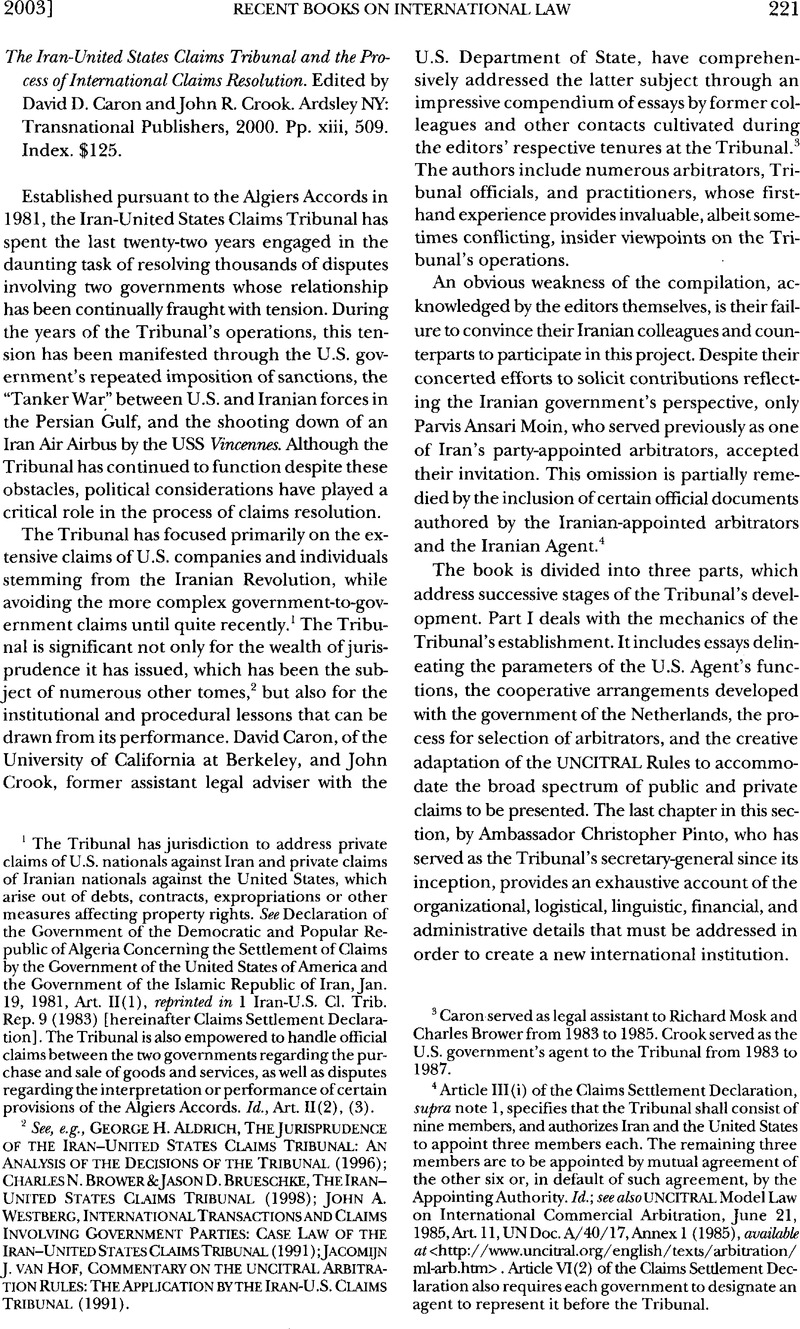No CrossRef data available.
Published online by Cambridge University Press: 27 February 2017

1 The Tribunal has jurisdiction to address private claims of U.S. nationals against Iran and private claims of Iranian nationals against the United States, which arise out of debts, contracts, expropriations or other measures affecting property rights. See Declaration of the Government of the Democratic and Popular Republic of Algeria Concerning the Settlement of Claims by the Government of the United States of America and the Government of the Islamic Republic of Iran, Jan. 19, 1981, Art. 11(1), reprinted in 1 Iran-U.S. Cl. Trib. Rep. 9 (1983) [hereinafter Claims Settlement Declaration] . The Tribunal is also empowered to handle official claims between the two governments regarding the purchase and sale of goods and services, as well as disputes regarding the interpretation or performance of certain provisions of the Algiers Accords. Id., Art. 11(2), (3).
2 See, e.g., Aldrich, George H., The Jurisprudence of the Iran-United States Claims Tribunal: An Analysis of the Decisions of the Tribunal (1996)CrossRefGoogle Scholar; Brower, Charles N. & Brueschke, Jason D., The Iranunited States Claims Tribunal (1998)Google Scholar; Westberg, John A., International Transactions and Claims Involving Government Parties: Case Law of the Iran-United States Claims Tribunal (1991)Google Scholar; van Hof, Jacomijn J., Commentary on the Uncitral Arbitration Rules: The Application by the Iran-U.S. Claims Tribunal (1991)Google Scholar.
3 Caron served as legal assistant to Richard Mosk and Charles Brower from 1983 to 1985. Crook served as the U.S. government’s agent to the Tribunal from 1983 to 1987.
4 Article III (i) of the Claims Settlement Declaration, supra note 1, specifies that the Tribunal shall consist of nine members, and authorizes Iran and the United States to appoint three members each. The remaining three members are to be appointed by mutual agreement of the other six or, in default of such agreement, by the Appointing Authority. Id.; see also UNCITRAL Model Law on International Commercial Arbitration, June 21, 1985, Art. 11, UN Doc. A/40/17, Annex 1 (1985), available at <http://www.uncitral.org/english/texts/arbitration/ml-arb.htm> . Article VI (2) of the Claims Settlement Declaration also requires each government to designate an agent to represent it before the Tribunal.
5 By contrast, the U.S.-appointed arbitrators have repeatedly voted to award damages to the Iranian government.
6 Reed notes with approval that the U.N. Compensation Commission, established to resolve Gulf War-related claims against Iraq, has learned from the mistakes of the Tribunal. In particular, the commission recognizes the importance of prioritizing small claims of private individuals, who are least able to absorb their own losses, and the utility of imposing strict time limits for deciding claims.
7 The Algiers Accords established an interest-bearing security account initially containing $1 billion to secure the payment of, and to pay, claims against Iran in accordance with the Claims Settlement Declaration. See Declaration of the Government of the Democratic and Popular Republic of Algeria, Jan. 19,1981, para. 7, reprinted in 1 Iran-U.S. Cl. Trib. Rep. 3,5-6 (1983). The Iranian government was required to ensure that the minimum balance in the account did not fall below $500 million. Id.
8 The suggestion of leakages by the Iranian arbitrators is also implicit in the concurring opinion of George H. Aldrich to ITT Industries v. Iran, 2 Iran-U.S. Cl. Trib. Rep. 348, 349 (1983) (stating that “the settlement may well have been inspired, at least in part, by the Respondent’s desire to prevent” certain views of his “from appearing in the Award”).